1996 CADILLAC SEVILLE window
[x] Cancel search: windowPage 14 of 354
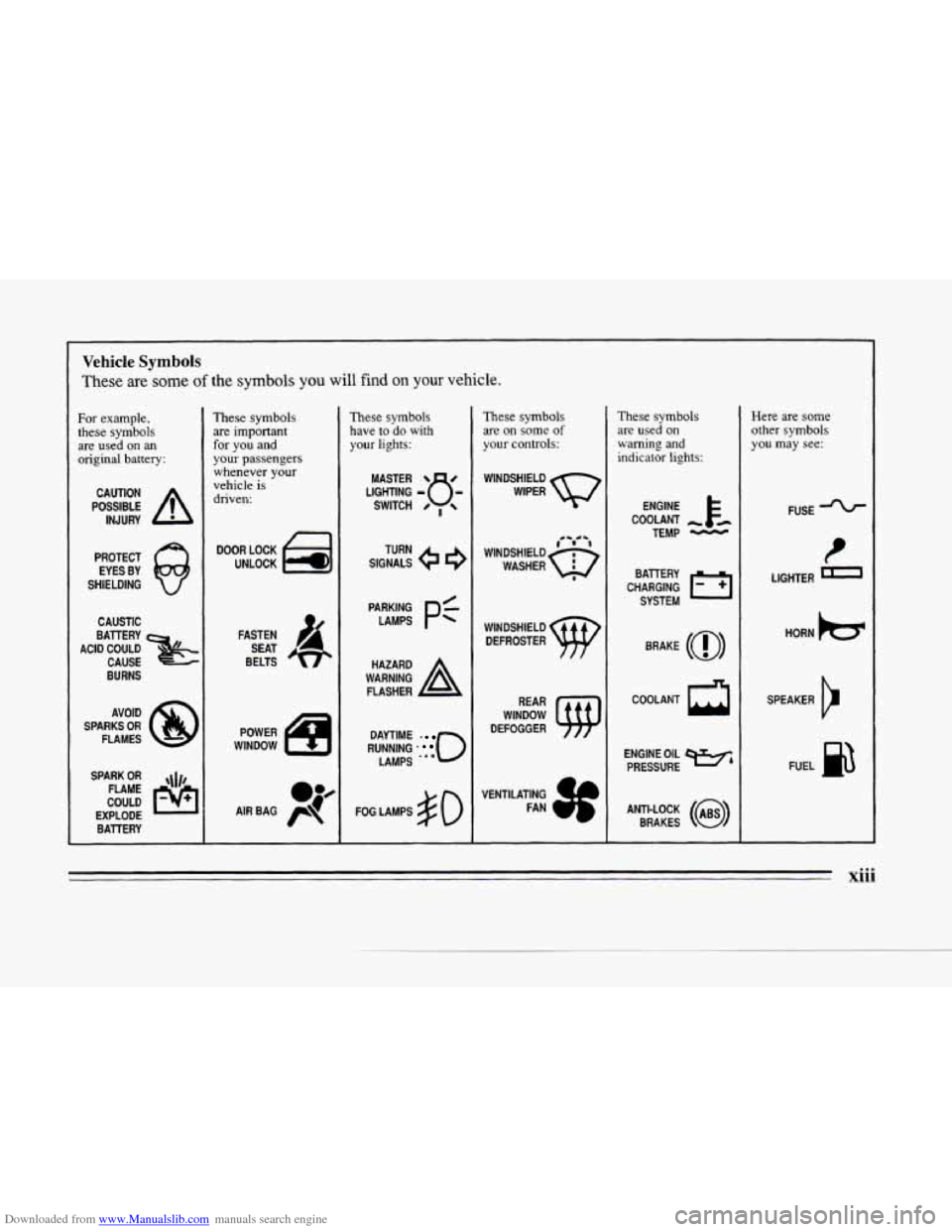
Downloaded from www.Manualslib.com manuals search engine e
e
c
Vehicle Symbols
These are some of the symbols you will find on your vehicle.
For example,
these symbols
are used
on an
original battery:
POSSIBLE A
CAUTION
INJURY
PROTECT
EYES BY
SHIELDING
CAUSTIC
BURNS AVOID
SPARKS
OR
FLAMES
SPARK
OR ,111,
COULD FLAME
EXPLODE BAllERY
These symbols
are important
for you and
your passengers
whenever your
vehicle
is
driven:
DOOR LOCK
UNLOCK
FASTEN SEAT
BELTS
POWER
WINDOW
These symbols have
to do with
your lights:
SIGNALS e
TURN
RUNNING
0
DAYTIME -
LAMPS -**
FOG LAMPS # 0
These symbols are on
some of
your controls:
WINDSHIELD
WIPER
WINDSHIELD DEFROSTER
WINDOW
DEFOGGER
VENTILATING FAN
These symbols
are used on
warning and
indicator lights:
COOLANT -
TEMP -
CHARGING I-1
BATTERY
SYSTEM
BRAKE
(a)
COOLANT a
ENGINE OIL w,
PRESSURE
ANTI-LOCK
(,)
BRAKES
Here are some
other symbols
you may see:
FUSE
LlGl ITER D
HORN k3
SPEAKER
k
FUEL B
xiii
Page 39 of 354
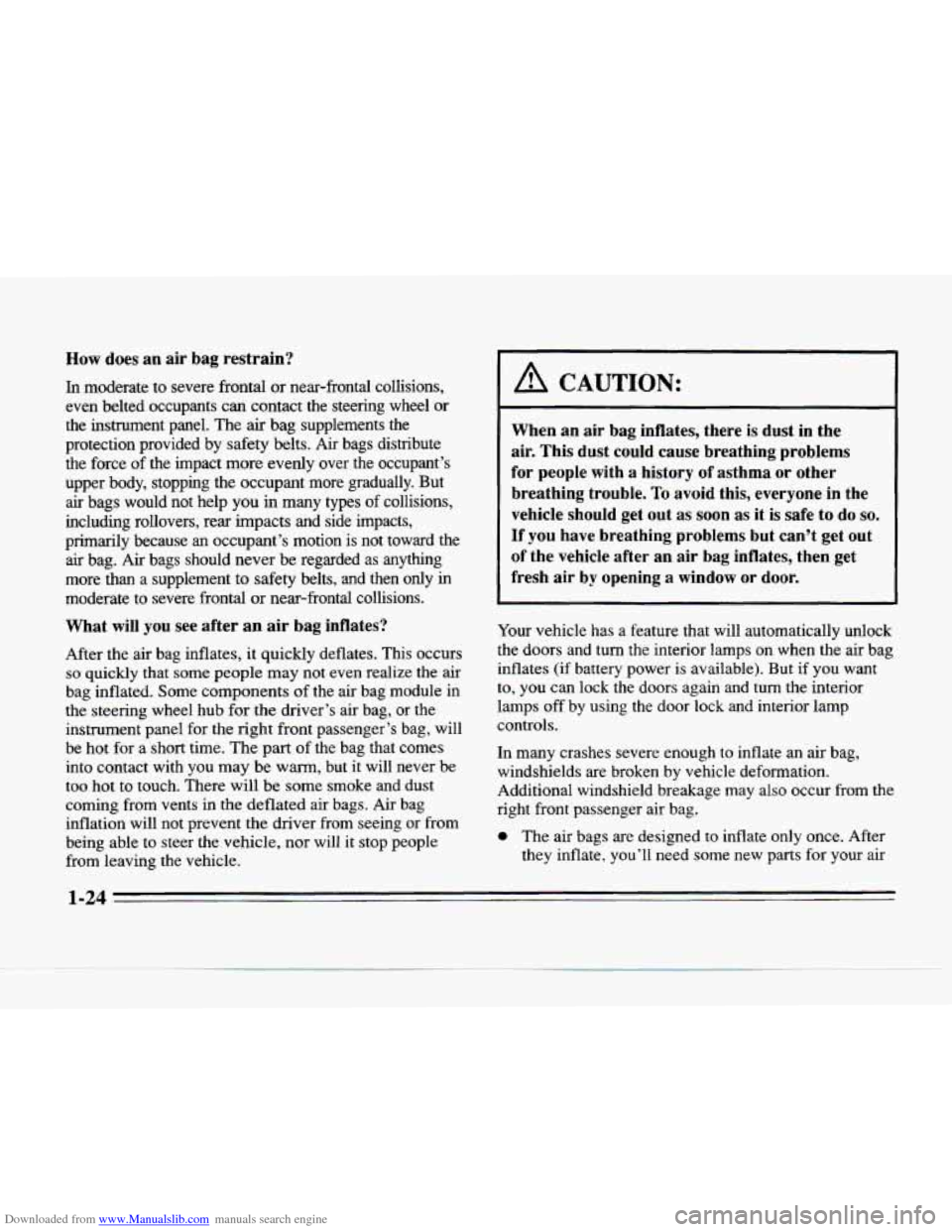
Downloaded from www.Manualslib.com manuals search engine How does an air bag restrain?
In moderate to severe frontal or near-frontal collisions,
even belted occupants can contact the steering wheel or
the instrument panel. The air bag supplements the
protection provided by safety belts.
Air bags distribute
the force of the impact more evenly over the occupant’s
upper body, stopping the occupant more gradually.
But
air bags would not help you in many types of collisions,
including rollovers, rear impacts and side impacts,
primarily because
an occupant’s motion is not toward the
air bag. Air bags should never be regarded as anything
more than
a supplement to safety belts, and then only in
moderate to severe frontal or near-frontal collisions.
What will you see after an air bag inflates?
After the air bag inflates, it quickly deflates. This occurs
so quickly that some people may not even realize the air
bag inflated. Some components
of the air bag module in
the steering wheel hub for
the driver’s air bag, or the
instrument panel for the right front passenger’s bag, will
be hot for a short time. The part
of the bag that comes
into contact with you
may be warm, but it will never be
too hot to touch. There will be some smoke and dust
coming from vents in the deflated air bags. Air bag
inflation will not prevent the driver from seeing or from
being able to steer the vehicle, nor will it stop people
from leaving the vehicle.
~
A CAUTION:
When an air bag inflates, there is dust in the
air. This dust could cause breathing problems
for people with a history of asthma
or other
breathing trouble.
To avoid this, everyone in the
vehicle should get out as soon as it is safe to do
so.
If you have breathing problems but can’t get out
of the vehicle after an air bag inflates, then get
fresh air by opening
a window or door.
Your vehicle has a feature that will automatically unlock
the doors
and turn the interior lamps on when the air bag
inflates
(if battery power is available). But if you want
to, you can lock the doors again and turn the interior
lamps
off by using the door lock and interior lamp
controls.
In many crashes severe enough
to inflate an air bag,
windshields are broken by vehicle deformation.
Additional windshield breakage may also occur
from the
right front passenger air bag.
0 The air bags are designed to inflate only once. After
they inflate, you’ll need
some new parts for your air
-24
Page 42 of 354
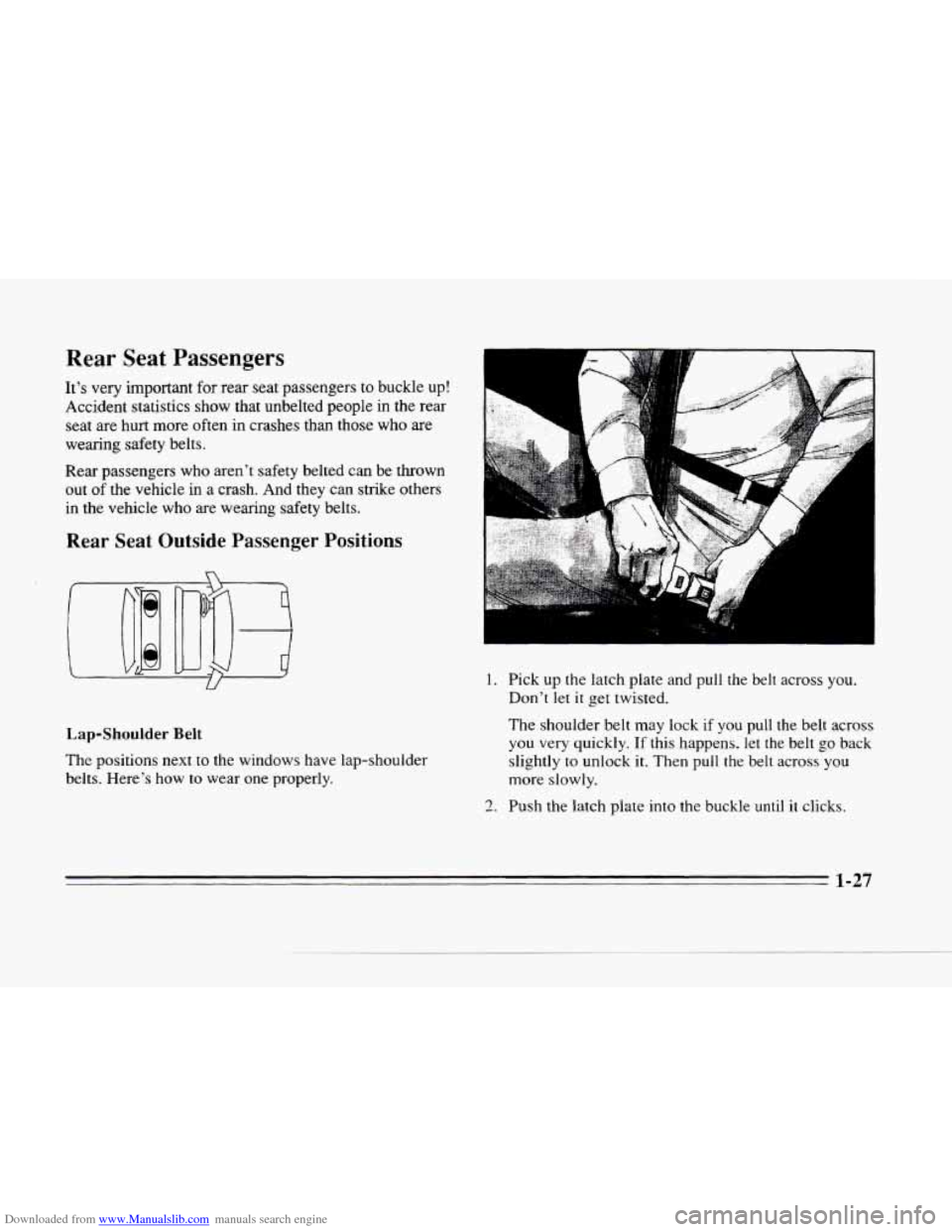
Downloaded from www.Manualslib.com manuals search engine c
Rear Seat Passengers
It’s very important for rear seat passengers to buckle up!
Accident statistics show that unbelted people
in the rear
seat
are hurt more often in crashes than those who are
wearing safety belts.
Rear passengers who aren’t safety belted can be thrown
out
of the vehicle in a crash. And they can strike others
in the vehicle who are wearing safety belts.
Rear Seat Outside Passenger Positions
i3
Lap-Shoulder Belt
The positions next to the windows have lap-shoulder
belts. Here’s how to wear one properly.
1. Pick up the latch plate and pull the belt across you.
Don’t let
it get twisted.
The shoulder belt may lock if you pull the belt across
you very quickly.
If this happens. let the belt go back
slightly to unlock it. Then pull the belt across you
more slowly.
2. Push the latch plate into the buckle until it clicks.
1-27
Page 56 of 354
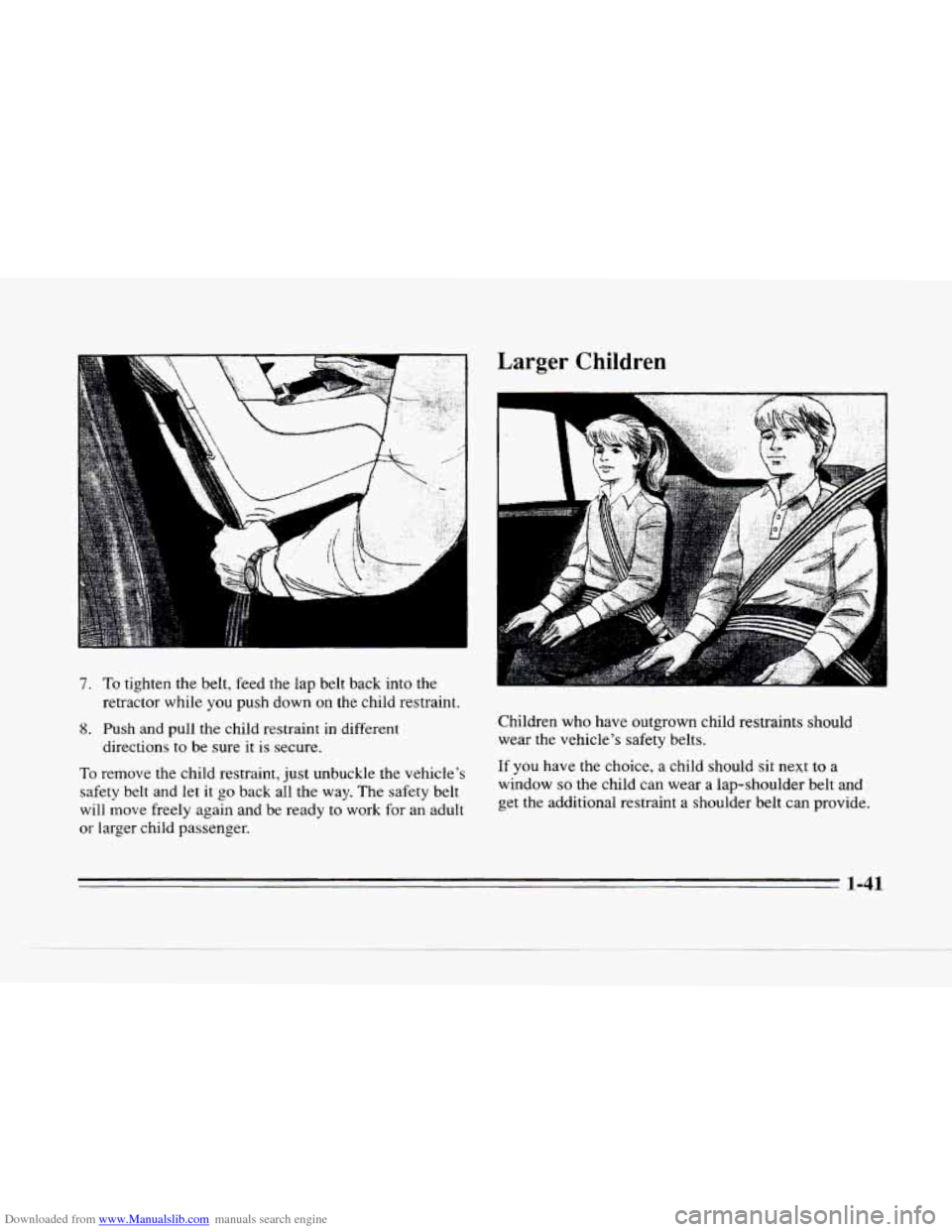
Downloaded from www.Manualslib.com manuals search engine k:.
7. To tighten the belt, feed the lap belt back into the
retractor while
you push down on the child restraint.
8. Push and pull the child restraint in different
directions
to be sure it is secure.
To remove the child restraint, just unbuckle the vehicle’s
safety belt and
let it go back all the way. The safety belt
will move freely again and be ready
to work for an adult
or larger child passenger.
Larger Children
1-
Children who have outgrown child restraints should
wear the vehicle’s safety belts.
If you have the choice, a child should sit next to a
window so the child can wear a lap-shoulder belt and
get the additional restraint a shoulder belt can provide.
1-41
Page 60 of 354
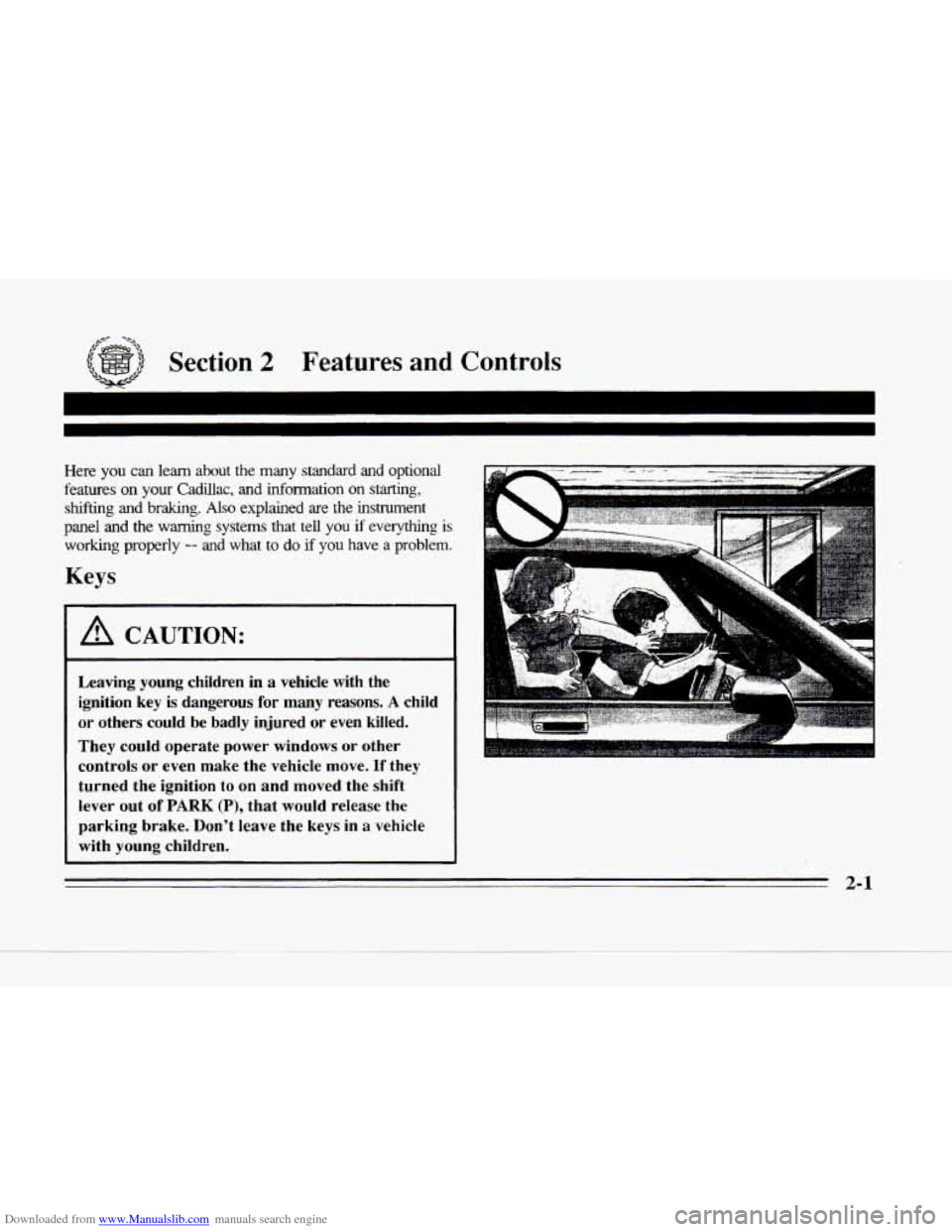
Downloaded from www.Manualslib.com manuals search engine ,-L- -*-,
Section 2 Features and Controls
Here you can learn about the many standard and optional
features on your Cadillac, and information on starting,
shrfting and braking. Also explained are the instrument
panel
and the warning systems that tell you if everything is
working properly -- and what to do if you have a problem.
Keys
A CAUTION:
Leaving young children in a vehicle with the
ignition key
is dangerous for many reasons. A child
or others could be badly injured
or even killed.
They could operate power windows or other
controls or even
make the vehicle move. If they
turned the ignition to
on and moved the shift
lever out
of PARK (P), that would release the
parking brake. Don't leave the keys in
a vehicle
with young children.
3:
yl . . . . . ,.
2-1
Page 69 of 354
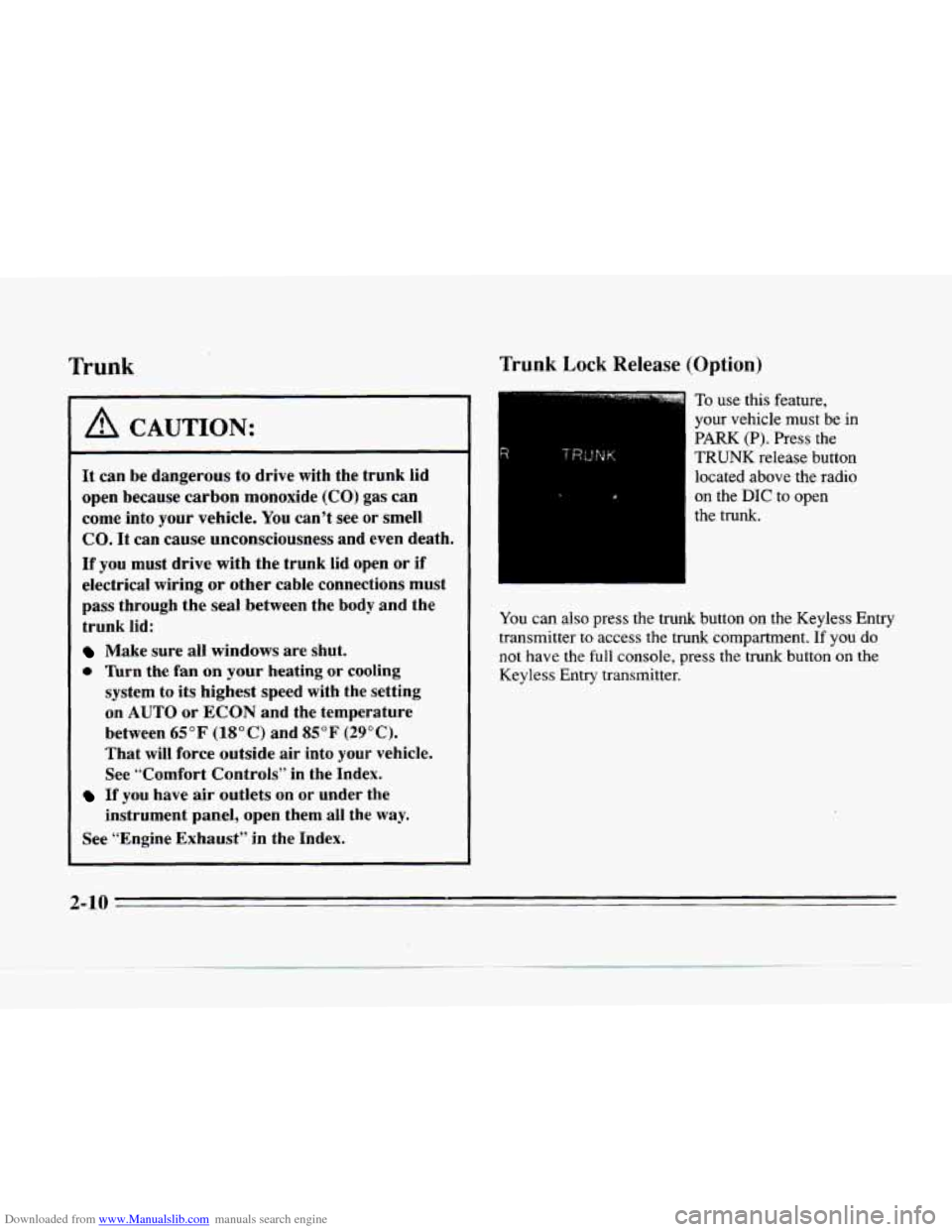
Downloaded from www.Manualslib.com manuals search engine Frunk
A CAUTION:
It can be dangerous to drive with the trunk lid
open because carbon monoxide
(CO) gas can
come into your vehicle.
You can’t see or smell
CO. It can cause unconsciousness and even death.
If you must drive with the trunk lid open or if
electrical wiring
or other cable connections must
pass through the seal between the body and the
trunk lid:
Make sure all windows are shut.
e lhrn the fan on your heating or cooling
system to its highest speed with the setting
on
AUTO or ECON and the temperature
between
65°F (18OC) and 85°F (29°C).
That will force outside air into your vehicle.
See “Comfort Controls” in the Index.
instrument panel, open them all the
way.
If you have air outlets on or under the
See “Engine Exhaust” in the Index.
Trunk Lock Release (Option)
TRUNK
To use this feature,
your vehicle must
be in
PARK (P). Press the
TRUNK release button
located above the radio
on the
DIC to open
the trunk. P
You can also press the trunk button on the Keyless Entry
transmitter to access the trunk compartment.
If you do
not have the full console, press the trunk button on the
Keyless Entry transmitter.
2-10
Page 71 of 354
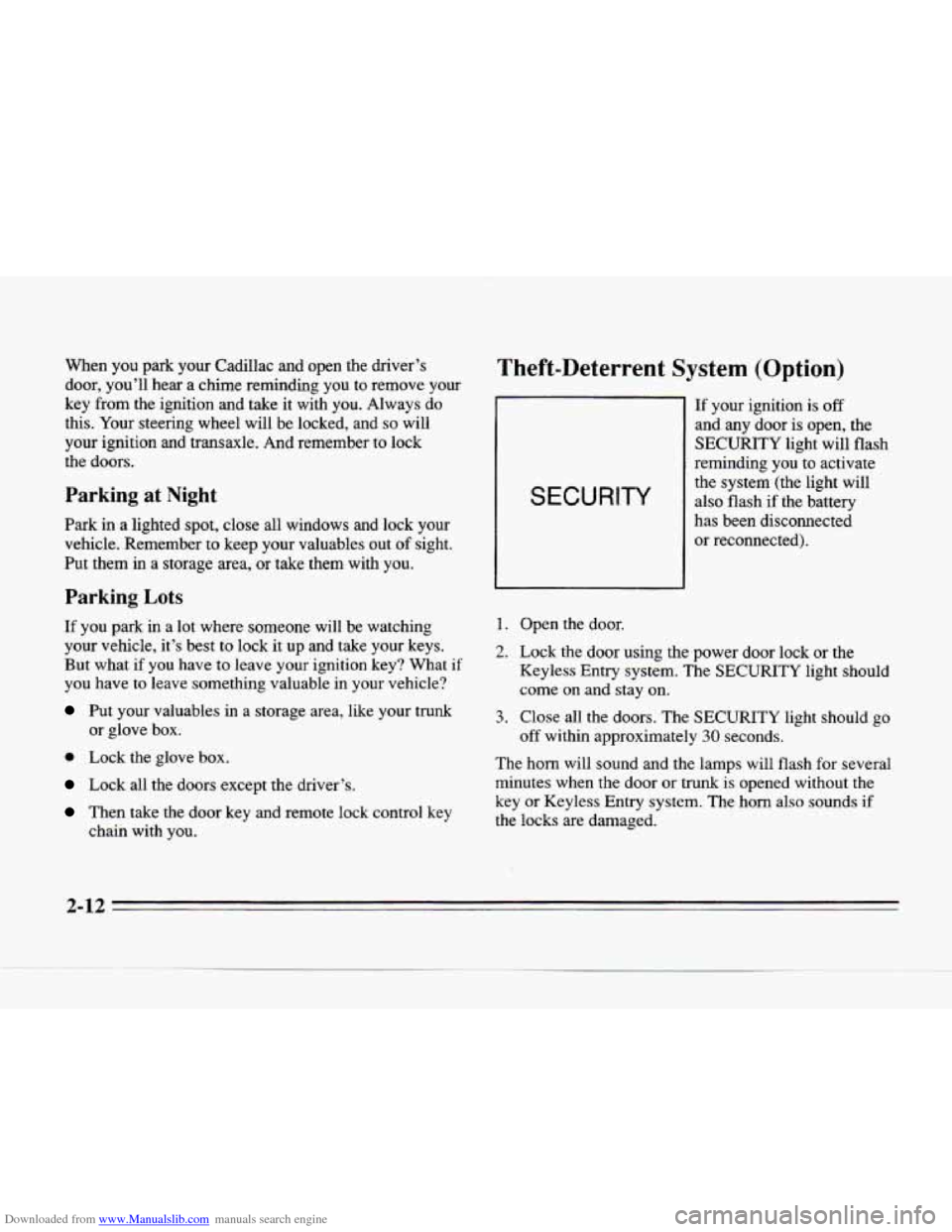
Downloaded from www.Manualslib.com manuals search engine When you park your Cadillac and open the driver’s
door, you’ll hear a chime reminding you to remove your
key
from the ignition and take it with you. Always do
this. Your steering wheel will be locked, and
so will
your ignition and transaxle. And remember
to lock
the doors.
Parking at Night
Park in a lighted spot, close all windows and lock your
vehicle. Remember to keep your valuables out
of sight.
Put them
in a storage area, or take them with you.
Parking Lots
If you park in a lot where someone will be watching
your vehicle, it’s best
to lock it up and take your keys.
But what if you have to leave your ignition key? What if
you have to leave something valuable in your vehicle?
Put your valuables in a storage area, like your trunk
0 Lock the glove box.
Lock all the doors except the driver’s.
Then take the door key and remote lock control key
or glove box.
chain with you.
Theft-Deterrent System (Option)
SECURITY
If your ignition is off
and any door is open, the
SECURITY light will flash
reminding you to activate
the system (the light will
also flash if the battery
has been disconnected
or reconnected).
1. Open the door.
2. Lock the door using the power door lock or the
Keyless Entry system. The SECURITY light should
come on and stay on.
3. Close all the doors. The SECURITY light should go
off within approximately 30 seconds.
The horn will sound and the lamps will flash for several
minutes when the door
or trunk is opened without the
key or Keyless Entry system. The horn also sounds if
the locks are damaged.
2-12 .- -
Page 72 of 354
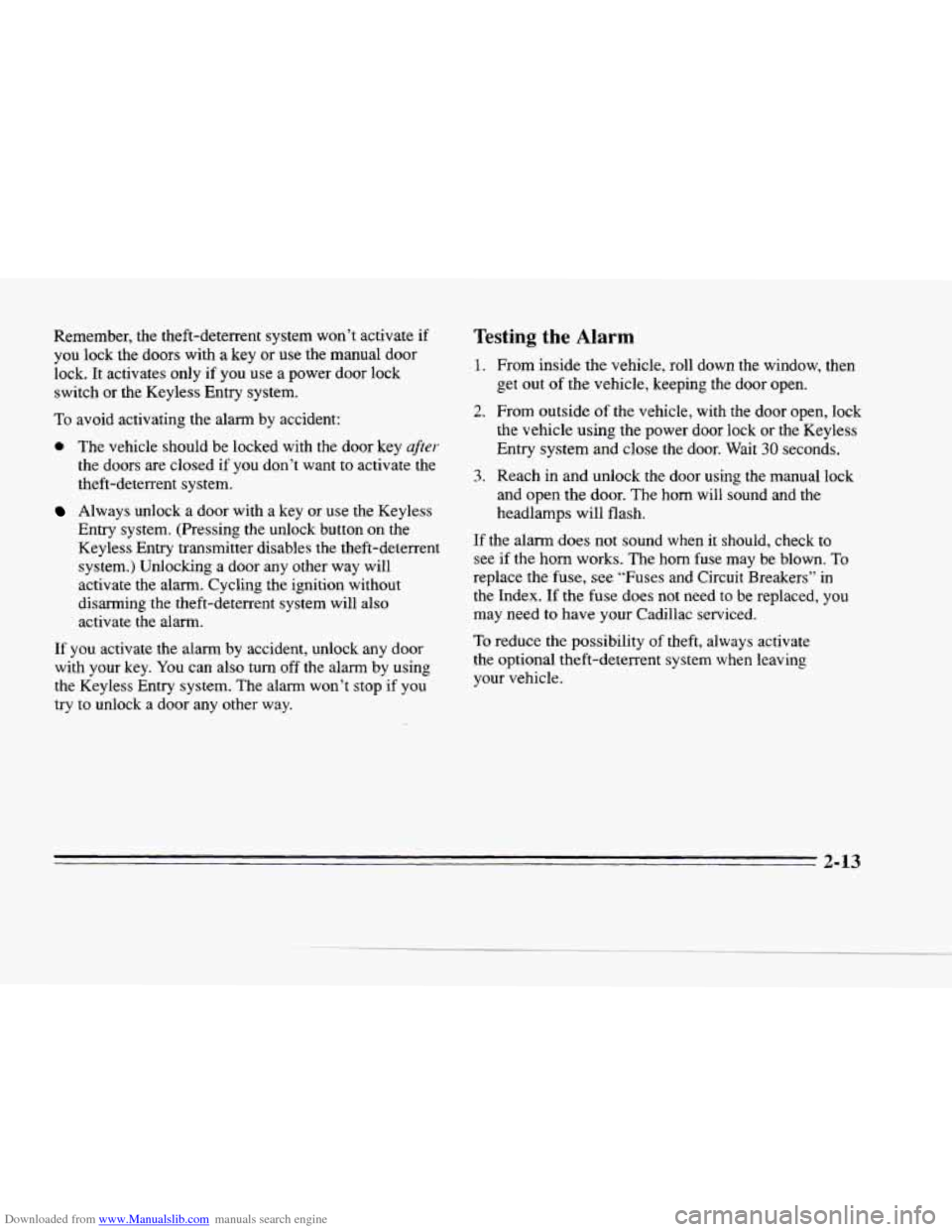
Downloaded from www.Manualslib.com manuals search engine F
c
Remember, the theft-deterrent system won’t activate if
you lock the doors with a key or use the manual door
lock. It activates only if you use a power door lock
switch or the Keyless Entry system.
To avoid activating the alarm by accident:
0 The vehicle should be locked with the door key after-
the doors are closed if you don’t want to activate the
theft-deterrent system.
Always unlock a door with a key or use the Keyless
Entry system. (Pressing the unlock button on the
Keyless Entry transmitter disables the theft-deterrent
system.) Unlocking a door any other way will
activate the alarm. Cycling the ignition without
disarming the theft-deterrent system will also
activate the alarm.
If you activate the alarm by accident, unlock any door
with your key.
You can also turn off the alarm by using
the Keyless Entry system. The alarm won’t stop if you
try to unlock a door any other way.
Testing the Alarm
1. From inside the vehicle, roll down the window, then
get out of the vehicle, keeping the door open.
2. From outside of the vehicle, with the door open, lock
the vehicle using the power door lock or the Keyless
Entry
system and close the door. Wait 30 seconds.
3. Reach in and unlock the door using the manual lock
and open the door. The horn will sound and the
headlamps will flash.
If the alarm does not sound when it should, check to
see if the horn works. The
horn fuse may be blown. To
replace the fuse, see “Fuses and Circuit Breakers” in
the Index. If the fuse does not need to be replaced, you
may need to have your Cadillac serviced.
To reduce the possibility of theft, always activate
the optional theft-deterrent system when leaving
your vehicle.